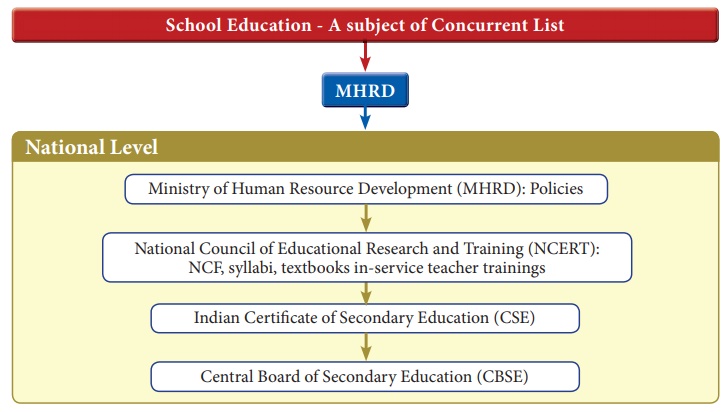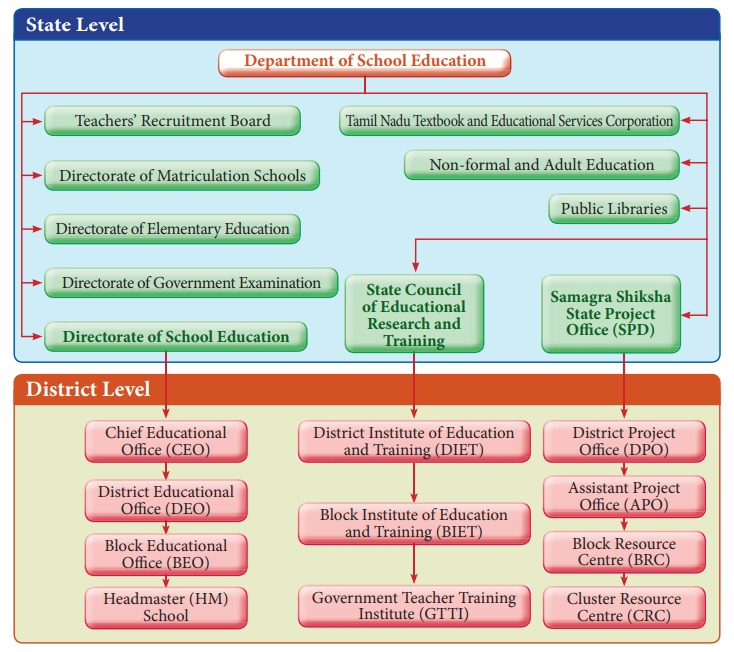Administrative Machinery in India | Political Science - Ministry, Department, Boards and Commissions | 12th Political Science : Chapter 6 : Administrative Machinery in India
Chapter: 12th Political Science : Chapter 6 : Administrative Machinery in India
Ministry, Department, Boards and Commissions
Ministry, Department, Boards and Commissions
Union Government Ministries/ Department
The main policy making institution in the Union
government is the central secretariat which comprises all the ministries and
departments which in turn characterized by certain patterns of structural
arrangements and functional specifications.
Structure of a Ministry
Ministry of Central Government has a three tier
structure consisting of
1. Political Head, who is a cabinet minister
assisted by minister of state and deputy minister. Sometimes a minister of
State may also be a political head of a ministry/department holding an
independent charge.
2. Secretariat organisation headed by a secretary
who is a career civil servant. He is assisted by Joint secretaries, Deputy
Secretaries, Undersecretaries and office establishment.
3. Executive organization under a head of the
department who is known by various designations like Director,
Director-General, Commissioner, Inspector-General, Chief Controller etc…
A ministry is primarily divided into departments.
Each department is divided into wings. Each wing is, in turn, divided into divisions,
which are further divided into branches. Each branch is divided into sections.
A section is the lowest level and smallest organizational unit of a ministry/
department.
Under the Government of India, Rules of Business,
1961, the ministries departments in the Government of India were classified into
different levels.
Department (Secretary)
Wing (Additional/Joint
Secretary)
Division (Deputy Secretary)
Branch (Under Secretary)
Section (Section Officer)
Central Secretariat
The Central Secretariat comprises of all the
ministries and departments of the central Government. Article 77 of the Indian
Constitution authorizes the President of India to make rules for more
convenient transaction of business of Central Government and for allocation of
such business among the ministries.
Role and Functions
The Central Secretariat is a policy making body of
the government and is not, to undertake work of execution, unless necessitated
by the lack of official agencies to perform certain tasks. The Central
Secretariat normally performs the following functions:
1. Assisting the minister in the discharge of his
policy making and parliamentary responsibilities.
2. Framing legislation, rules and principles of procedure.
3. Sectoral planning and programme formulation.
4. Budgeting and control of expenditure in respect
of activities of the Ministry/ department.
5. Supervision and control over the execution of
policies and programmes.
6. Initiating steps to develop greater personnel
and organizational competence both in the ministry/ department and its
executive agencies.
7. Coordination and interpretation of policies,
assisting other branches of government and maintaining contact with state
administration.
Cabinet Secretariat
Functions
The Cabinet Secretariat functions directly under
the Prime Minister. The administrative head of the Secretariat is the Cabinet
Secretary who is also the ex-officio Chairman of the Civil Services Board. The
business allocated to Cabinet Secretariat under Government of India (Allocation
of Business) Rules, 1961 includes (i) Secretarial assistance to the Cabinet and
Cabinet Committees; and (ii) Rules of Business.
The Cabinet Secretariat is responsible for the
administration of the Government of India (Transaction of Business). The
Secretariat assists in decision-making to the Government by ensuring
Inter-Ministerial coordination, ironing out differences amongst
Ministries/Departments and evolving consensus through the instrumentality of the
standing/adhoc Committees of Secretaries. Management of major crisis situations
in the country and coordinating activities of various ministries.


Organisation of Cabinet Secretariat
The Cabinet Secretariat has three wings
v Civil wing
v Military wing
v Intelligence wing
Civil wing - It is the main wing and provides aid, advice and assistance to
the Union cabinet.
Military wing - provides
secretarial assistance to the
defence committee of the cabinet, the military affairs committee etc.
Intelligence wing - it deals with the matters pertaining to the joint
intelligence committee of the cabinet.
Other organizations are - RAW,
Director General of Security, SPG, Joint intelligence group, DG public
grievances (1988), National Authority, Chemical Weapons Convention.
Support to Cabinet Committees
The secretarial assistance, provided by Cabinet
Secretariat to the Cabinet and Cabinet committees, includes
v Convening of the meetings of the Cabinet and its
Committees on the orders of the Prime Minister.
v Preparation and circulation of the agenda.
v Circulation of papers related to the cases on the agenda.
v Preparation of record of discussions.
v Circulation of the record of
discussions after obtaining the approval of the Prime Minister.
v Monitoring
implementation of decisions taken by the Cabinet and its Committees.
Union Government-Apex Bodies
v President of India
v Vice President of
India
v Cabinet Secretariat
v Election Commission
of India
v Union Public Service
Commission (UPSC)
v National Human Rights
Commission (NHRC), India
v Comptroller and
Auditor General (CAG) of India,
v Indian Audit
and Accounts Department
v NITI Aayog - National
Institution for Transforming India
v National Commission
for Women (NCW)
v National Commission
for Scheduled Tribes (NCST)
v Fifteenth Finance
Commission of India
v National
Commission for Minorities(NCM)
v Insurance
Regulatory and Development Authority (IRDA)
v Office of the
Principal Scientific Adviser
v The Cabinet
Secretariat is the custodian of the papers of the Cabinet meetings.
Cabinet Secretary
The office of cabinet secretary was created in
India in 1950. The first Cabinet secretary was N.R.Pillai. The Cabinet
Secretary is the head of the Cabinet Secretariat. He is given a top place among
the civil servants. Thus, he is the senior most civil servant in India.
The Prime Minister’s Office (PMO)
The Prime Minister’s Office (PMO) consists of the
immediate staff of the Prime Minister of India. The PMo was originally called
the Prime Minister’s Secretariat until 1977, when it was renamed during the
Morarji Desai ministry.
Office of Principal Scientific Adviser
The Office of the Principal Scientific Adviser to the
Government of India (O/o of PSA) was set-up in November, 1999, primarily to:
v Evolve polices, strategies and missions for the
generation of innovations and support systems for multiple applications,
v Generate science and technology tasks in critical
infrastructure, economic and social sectors in partnership with Government
departments, institutions and industry,
v Office of PSA also services the Prime Minister’s Science,
Technology and Innovation Advisory Council (PM- STIAC)
v Office of PSA has been placed administratively
under the Cabinet Secretariat in August, 2018.
The PMo provides secretarial assistance to the
Prime Minister. It is headed by the Principal Secretary to the Prime Minister.
The PMo includes the anti-corruption unit and the public wing dealing with
grievances. The office houses the Prime Minister and few selected officers of
Indian Civil Service who work with him to manage and coordinate government and
his office. The Prime Minister through his office coordinates with all ministers
in the central union cabinet, minister of independent charges and governors and
ministers of state government.
Related Topics